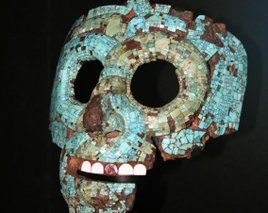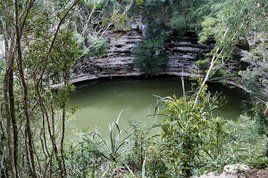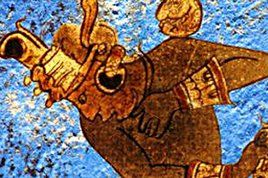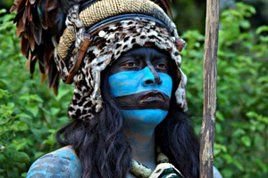
© Ancient-tides.blogspot.comA Mayan mask with still vibrant blue tiles
Azul Maya, or Maya Blue, is a vibrant color that was created and used by the classic and post-classic Maya civilizations more than 1700 years ago, and which is still evident in Mayan ruins and archeological treasures.
The pigment was used to decorate household items, murals, sculptures and, its best known use, for adorning human sacrifices, held important symbolic value for the ancient Maya. The amazing color was extremely important for ritual.
For the Maya, blue was the color of the rain deities, particularly the god Chaahk, their rain god and the patron of agriculture.
When the Maya made sacrifices to Chaahk, they painted the objects - or people - bright Mayan blue prior to the ritual "killing" of the person or animal to release its spirit. After the ritual killing, the Mayan priest threw the object into water, often the Cenote Sagrado, or Sacred Cenote, at Chichen Itza, as an offering to Chaahk in hopes for rain and bountiful crops.

Cenote Sagrado at Chitchen Itza
According to numerous accounts, humans were not always killed before priests threw them into the Sacred Cenote. Instead, they were painted the bright blue and thrown alive into the Cenote. In the extremely unlikely chance that a victim survived the attempted "sacrifice," the priests announced him as a messenger of the gods, and he was honored for the remainder of his life.
American born archaeologist and diplomat Edward H. Thompson spent most of his life studying ancient Mayan culture and purchased the land that included Chichen Itza and Cenote Sagrado. His excavation (1904-1910) of the well at Cenote Sagrado resulted in the recovery of artifacts of gold, jade and copper, as well as pre-columbian cloth, weapons and tools that had been encased in the thick clay at the bottom of the well.
Thompson also recovered human remains, mostly males that were sacrificed to Chaahk.
While scientists and anthropologists have long understood the purpose of the amazing color, the mechanism for creating the long-lasting color has baffled experts. The pigment, used on murals and pottery, remains vibrant after thousands of years, which is extremely rare for any color, especially ones made from natural ingredients.
The Maya Blue color is so durable that even most forms of acid do not remove it. In many cases, the only color remaining on artifacts and murals is the Maya Blue; the others having completely faded away.

Mayan warrior on Azul Maya background
Recent studies show that the color contains the leaves of the indigo plant and a clay mineral called palygorskite; but scientist were perplexed over the method of mixing the two to create the amazing color. They agreed it likely was heated with Copal incense, a tree resin, during the ritual, which somehow bound the ingredients to create the color.
The process of using the heat to absorb the indigo into the clay is the secret that appears to make the color so stable. Molecular x-rays show that the clay fibers contain channels filled with water molecules. When the clay is heated, the water is exchanged for the indigo, which is sealed in place by what scientists call a "gatekeeper molecule" which prohibits the indigo from escaping.
The indigo molecule becomes seared into the clay, creating an extremely stable chemical. In essence, the indigo-clay combination becomes a new compound.

A present day warrior wearing Azul Maya pigment
For the Maya, the brilliant blue color was a spiritual representation of the rain god. For people today, it is another example of the incredible, possibly unrealized, technology of this ancient people.
Has anyone else seen the Bill Ryan interview/slideshow with Klaus Dona? Hidden History of the Human Race (youtube) of course there is no way to be sure about this but the color of these tiles bears a remarkable similarity to some rocks found in Africa represented as "tears of the gods" that Mr. Dona was unable to have analyzed for content...